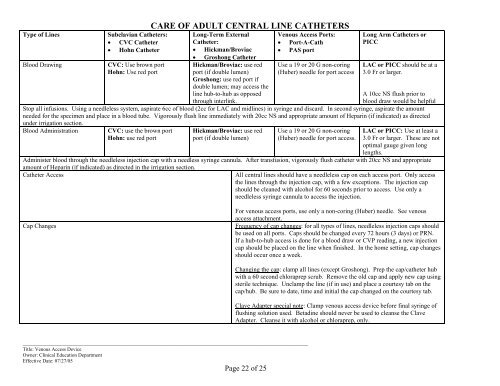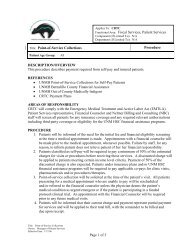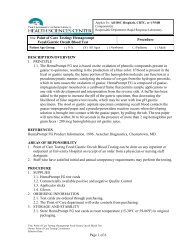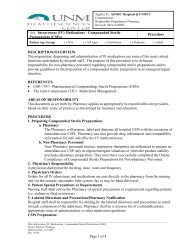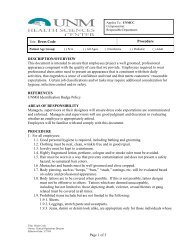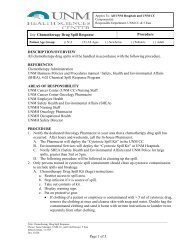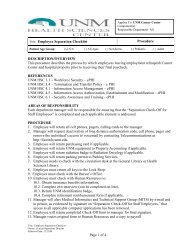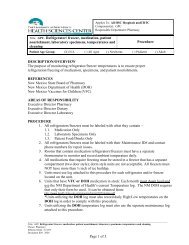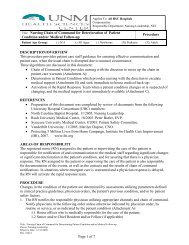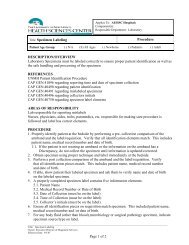Page 1 of 25 DESCRIPTION/OVERVIEW The purpose of this ...
Page 1 of 25 DESCRIPTION/OVERVIEW The purpose of this ...
Page 1 of 25 DESCRIPTION/OVERVIEW The purpose of this ...
Create successful ePaper yourself
Turn your PDF publications into a flip-book with our unique Google optimized e-Paper software.
Type <strong>of</strong> Lines<br />
Blood Drawing<br />
Subclavian Catheters:<br />
• CVC Catheter<br />
• Hohn Catheter<br />
CVC: Use brown port<br />
Hohn: Use red port<br />
CARE OF ADULT CENTRAL LINE CATHETERS<br />
Long-Term External<br />
Catheter:<br />
• Hickman/Broviac<br />
• Groshong Catheter<br />
Hickman/Broviac: use red<br />
port (if double lumen)<br />
Groshong: use red port if<br />
double lumen; may access the<br />
line hub-to-hub as opposed<br />
Venous Access Ports:<br />
• Port-A-Cath<br />
• PAS port<br />
Use a 19 or 20 G non-coring<br />
(Huber) needle for port access<br />
Long Arm Catheters or<br />
PICC<br />
LAC or PICC should be at a<br />
3.0 Fr or larger.<br />
A 10cc NS flush prior to<br />
blood draw would be helpful<br />
through interlink.<br />
Stop all infusions. Using a needleless system, aspirate 6cc <strong>of</strong> blood (2cc for LAC and midlines) in syringe and discard. In second syringe, aspirate the amount<br />
needed for the specimen and place in a blood tube. Vigorously flush line immediately with 20cc NS and appropriate amount <strong>of</strong> Heparin (if indicated) as directed<br />
under irrigation section.<br />
Blood Administration<br />
CVC: use the brown port<br />
Hohn: use red port<br />
Hickman/Broviac: use red<br />
port (if double lumen)<br />
Use a 19 or 20 G non-coring<br />
(Huber) needle for port access.<br />
LAC or PICC: Use at least a<br />
3.0 Fr or larger. <strong>The</strong>se are not<br />
optimal gauge given long<br />
lengths.<br />
Administer blood through the needleless injection cap with a needless syringe cannula. After transfusion, vigorously flush catheter with 20cc NS and appropriate<br />
amount <strong>of</strong> Heparin (if indicated) as directed in the irrigation section.<br />
Catheter Access<br />
All central lines should have a needleless cap on each access port. Only access<br />
the lines through the injection cap, with a few exceptions. <strong>The</strong> injection cap<br />
should be cleaned with alcohol for 60 seconds prior to access. Use only a<br />
needleless syringe cannula to access the injection.<br />
Cap Changes<br />
For venous access ports, use only a non-coring (Huber) needle. See venous<br />
access attachment.<br />
Frequency <strong>of</strong> cap changes: for all types <strong>of</strong> lines, needleless injection caps should<br />
be used on all ports. Caps should be changed every 72 hours (3 days) or PRN.<br />
If a hub-to-hub access is done for a blood draw or CVP reading, a new injection<br />
cap should be placed on the line when finished. In the home setting, cap changes<br />
should occur once a week.<br />
Changing the cap: clamp all lines (except Groshong). Prep the cap/catheter hub<br />
with a 60 second chloraprep scrub. Remove the old cap and apply new cap using<br />
sterile technique. Unclamp the line (if in use) and place a courtesy tab on the<br />
cap/hub. Be sure to date, time and initial the cap changed on the courtesy tab.<br />
Clave Adapter special note: Clamp venous access device before final syringe <strong>of</strong><br />
flushing solution used. Betadine should never be used to cleanse the Clave<br />
Adapter. Cleanse it with alcohol or chloraprep, only.<br />
_________________________________________________________________________________________________________________<br />
Title: Venous Access Device<br />
Owner: Clinical Education Department<br />
Effective Date: 07/27/05<br />
<strong>Page</strong> 22 <strong>of</strong> <strong>25</strong>


